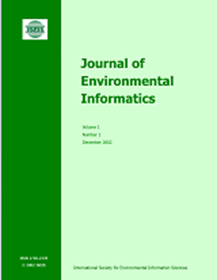利用图像处理确定微泡洗涤器最佳操作条件的方法
IF 5.4
1区 环境科学与生态学
Q1 ENVIRONMENTAL SCIENCES
引用次数: 11
摘要
本文提出了一种基于图像处理的低压微泡(LPMB)洗涤器界面面积浓度(IAC)计算模型,便于通过流型分析确定洗涤器的运行条件。LPMB洗涤器利用气泡流使两相系统的界面面积最大化。微气泡因其微观尺寸、高停留时间和高传质效率而受到人们的关注。LPMB洗涤器保持负出口压力以产生气体流动,这反过来又产生微气泡,通过雾化器中的三个阻挡板中断气体流动。这种气体流动产生不同气泡大小的气泡通量。为了获得气泡的特性,我们分析了20个雾化器图像中出现了这种复杂的通量。采用Open-CV Python算法计算气泡大小、气泡数、气体空隙率和IAC。为了验证最合适的气泡流动模式,在240、360和450 mmAq的压力差下进行了案例研究。在360 mmAq条件下,气泡小于50µm的百分比最低,但气泡总数、孔隙率和IAC最高。本研究的结果证实,在氧化溶液中使用LPMB洗涤器,NOX、SOX和粉尘的减少率分别为92.6%、93.9%和99.9%。这些结果可用于验证其他用于商业和实际应用的两相系统的气泡反应性。本文章由计算机程序翻译,如有差异,请以英文原文为准。
Method for Determining Optimum Operational Conditions of Microbubble Scrubber Using Image Processing
This paper presents an image-processing-based model for calculating the interfacial-area concentration (IAC) of a low-pressure microbubble (LPMB) scrubber, which facilitates the determination of operational conditions of the scrubber via flow-pattern analysis. The LPMB scrubber maximizes the interfacial area of two-phase systems using the bubbly flow. Microbubbles have received attention due to their microscopic sizes, high residence time, and high mass-transfer efficiency. The LPMB scrubber maintains a negative outlet pressure to generate gas flow, which in turn generates microbubbles interrupting gas flow with three blocking plates in the atomizer. This gas flow generates a bubbly flux with different bubble sizes. To obtain bubble characteristics, we analyzed 20 atomizer images where this complex flux occurs. Bubble size, number of bubbles, gas void fraction, and IAC were calculated using an Open-CV Python algorithm. To validate the most appropriate bubble flow patterns, case studies were conducted at pressure difference of 240, 360, and 450 mmAq. The 360 mmAq condition had the lowest percentage of bubbles smaller than 50 µm, but the total number of bubbles, void fraction, and IAC were the highest. The results obtained in this study confirm that using an LPMB scrubber in an oxidizing solution facilitates reductions of 92.6, 93.9, and 99.9% in NOX, SOX, and dust, respectively. These results could be used to validate the bubble reactivity of other two-phase systems intended for commercial and practical applications.
求助全文
通过发布文献求助,成功后即可免费获取论文全文。
去求助
来源期刊

Journal of Environmental Informatics
ENVIRONMENTAL SCIENCES-
CiteScore
12.40
自引率
2.90%
发文量
7
审稿时长
24 months
期刊介绍:
Journal of Environmental Informatics (JEI) is an international, peer-reviewed, and interdisciplinary publication designed to foster research innovation and discovery on basic science and information technology for addressing various environmental problems. The journal aims to motivate and enhance the integration of science and technology to help develop sustainable solutions that are consensus-oriented, risk-informed, scientifically-based and cost-effective. JEI serves researchers, educators and practitioners who are interested in theoretical and/or applied aspects of environmental science, regardless of disciplinary boundaries. The topics addressed by the journal include:
- Planning of energy, environmental and ecological management systems
- Simulation, optimization and Environmental decision support
- Environmental geomatics - GIS, RS and other spatial information technologies
- Informatics for environmental chemistry and biochemistry
- Environmental applications of functional materials
- Environmental phenomena at atomic, molecular and macromolecular scales
- Modeling of chemical, biological and environmental processes
- Modeling of biotechnological systems for enhanced pollution mitigation
- Computer graphics and visualization for environmental decision support
- Artificial intelligence and expert systems for environmental applications
- Environmental statistics and risk analysis
- Climate modeling, downscaling, impact assessment, and adaptation planning
- Other areas of environmental systems science and information technology.
 求助内容:
求助内容: 应助结果提醒方式:
应助结果提醒方式:


